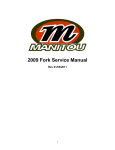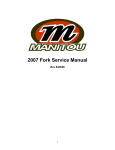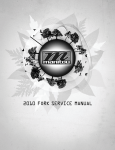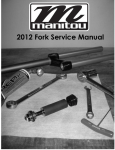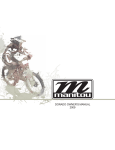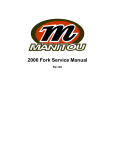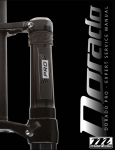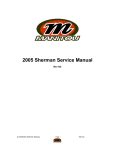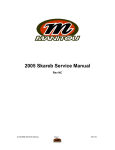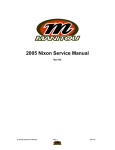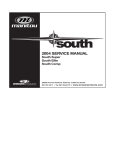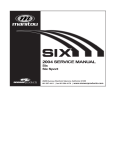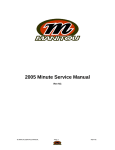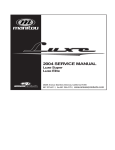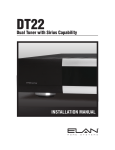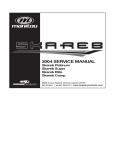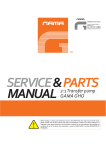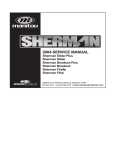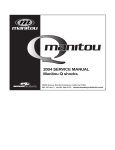Download 2008 Fork Service Manual
Transcript
2008 Fork Service Manual Rev 11/13/08 1 Table of Contents Description Page Introduction and Suspension Terminology 1-7 Section 1 - Disassembly/Assembly Instructions – Damping Systems 8-13 Section 2 - Disassembly/Assembly Instructions – Spring Systems 14-21 Section 3 - Disassembly/Assembly Instructions – Castings 22-23 Troubleshooting Chart 24-25 Technical Information – Oil Levels, Torque Specs, Ect. Contact Information Hayes Bicycle Group 6750 W Florist Ave Milwaukee, WI 53218 Toll Free: Direct: FAX: E-mail: Web site: (888) 686-3472 (262) 242-4300 (414) 462-0214 [email protected] www.manitoumtb.com 2 26 INTRODUCTION This manual is intended to guide the user through basic service of Manitou front forks. Service is supported by the identification of common parts and assemblies that have been assembled into Service Kits. The purpose of this manual will be to describe conditions that may drive the need for service and to provide installation instructions for the kits. Due to the time-consuming nature of suspension fork service, at this time our primary focus is to offer service kits that minimize the amount of downtime and labor involved. Important information is highlighted in this manual by the following notations: WARNING Failure to follow WARNING instructions could result in severe injury or death to the person inspecting or repairing the suspension fork or the user. CAUTION A CAUTION a caution indicates special precautions that must be taken to avoid damage to the product. NOTE A NOTE provides key information to make procedures easier or clearer GENERAL WARNING: Suspension forks by design can contain preloaded springs, gases and fluids under extreme pressure and warnings contained in this manual must be observed to reduce the possibility of injury or possible death. Following these instructions can help you reduce the risk of being injured. Any questions in regards to the information in this manual should be directed to Manitou Customer Service at (888) 6863472. WARNING: Suspension forks uses preloaded spring(s) to provide compression spring resistance. This system must be relieved of preload prior to servicing. Failure to relieve air pressure could result in injury or possible death. CAUTION: Suspension forks use precision machined aluminum and other soft alloy components. Using correct tools for assembly is essential to prevent damage. 3 FRONT SUSPENSION TERMINOLOGY Air Cap – Top cap that threads into top of air/spring leg (this is the left leg of the fork as you are seated on the seat). Forks may be controlled with an air/spring or a coil spring. The air cap contains the Schrader Valve, which is used to control the spring rate or SAG of air forks. Air Spring – A mechanism that is used to control the SAG of an air fork. Arch – A support that connects the two outer lower legs of the casting so as to keep them moving in unison. Boss – The word used to describe an outer casting that has brake posts for V-brakes or cantilever brakes. Bottom Out Bumper – A rubber or elastomer device that absorbs the shock that occurs when a suspension is compression to its limit. Bushings – A cylindrical sleeve between a fork stanchion tube (inner leg) and a fork outer casting (slider), which facilitates the sliding movement between these two parts. Cartridge Damping – Provides better oil flow, bump sensitivity, and improved damping control in long travel applications. Coil Spring – A coiled piece of metal that acts as a spring to help suspend a fork. Compression – The phase of the suspension operation in which the wheel travels up, or travels closer to the frame. The suspension forks reaction to a bump in the trail. Compression Damping – Restriction of the rate that the suspension compresses under load. Crown Steer Assembly – the stanchion legs (inner legs), the fork crown, and the steer tube pressed together as one assembly. This assembly is then finished by adding all of the fork internals and then outer casting (slider). Damping – A function that modifies the rate of suspension compression or rebound. Detent – An indentation that causes a rotating adjuster to stop at fixed increments. Drop Out – The end of an outer casting (slider) where the wheel attaches. Dust Boot – Usually a piece of rubber in the shape of a cylinder with baffles to allow it to compress as the fork compresses through its travel. Its function is to help keep dirt and water from getting into the inner legs of the fork. FRONT SUSPENSION TERMINOLOGY (CONT.) FFD – Fluid Flow Damping. A Manitou patented low cost oil damping system. The compression damping is non-adjustable and the rebound damping may be non-adjustable or adjustable damping. Fork Crown – The component that joins the stanchion tubes (inner legs) to the steer tube of the fork. Hydraulic Fork Oil – Oil used in suspension designs to provide damping. It has special characteristics that determine how it reacts when exposed to compressed air, how it changes viscosity when its temperature changes, and how it moves through valves. 4 Hydraulic Lock Out – a condition caused when the mixture of air and damping oil is out of balance. It is caused when there is too little air space in a chamber, not allowing the fork to compress through its travel. IS2 Integrated Stem System – integrates top triple clamp with bar mount, eliminating the need for a stem. Flip Flop mount allows for 45mm or 60mm stem measurements and spacers allow bar height adjustments. Includes shims for both 31.8 and 25.4mm handlebars. Infinite Travel System (IT) – A handle-bar mounted air travel adjust system that allows the rider to change the fork travel (and ride height) without a spring rate change. The travel can be changed from full compression to full rebound and at any place in between. Intrinsic Damping– speed sensitive SPV based damping system for long travel applications. Provides better sensitivity to small bumps and superior bottoming resistance. Lock Out – a special function that restricts the compression of the fork from moving. It is generally controlled by an external knob that is activated when a rider does not want the fork to move, thus eliminating extra energy needed to overcome the bobbing forces of the fork. MCU – (Micro-Cellular Urethane) Special urethane that is filled with tiny air cells that act like springs when the elastomer is compressed. No Boss - The word used to describe an outer casting that has no brake posts for V-brakes or cantilever brakes. This casting is to be used for disk brakes only. No Tools Hex Lock Axle – Update of patented Hex Lock through axle provides simple and effective wheel removal system without requiring tools. Features dual quick release to remove pinch pressure and the axle is tighten and loosened with hand turned side tension bolt. Oil Damping – A system that uses the resistance to oil flow through holes in a valve to provide a means to alter the rate of suspension compression or rebound. Oil Level – The level of damping oil needed for the optimal damping performance of a suspension. It is measured as the air space distance between the top of the stanchion leg (inner leg) and the height of the oil inside of the leg. The fork must be completely extended in order to get an accurate measurement. O-Ring – A soft, flexible neoprene or Buna rubber ring with a round cross-section, which is used for sealing and retention. FRONT SUSPENSION TERMINOLOGY (CONT.) Oil Weight – A description of the relative viscosity of oil, such as hydraulic oil. Oil with low weight numbers (5wt or 7wt) flows through the valving with less resistance than higher weight numbers (10or 15 wt). One Point Five Standard - 1.5 inch interface standard for frame head tubes, headset, cups, stem, and steer tubes which allows for the lightest weight and strongest design in 170mm single crown forks. This design greatly improves the control and steering precision of the fork. It is used predominately on forks with longer travel and the intended use is for more hardcore, extreme riding. Outer Casting – (see Slider) Preload – A condition of compressing a spring or elastomer before the operating loads are put on the suspension, so that it provides a stiffer spring rate. 5 Piston – In front suspension, the part of the damper that slides back and forth inside of the damping leg that houses the valves. It can also refer to the air piston in the air/spring assembly that slides back and forth compressing the air, thus causing a change in the spring rate of the suspension. Porosity – The condition or property of having pores in a material that will allow gas or liquid to pass through it. Quad Ring seal – New seal that replaces standard o-rings in designs that require more efficient air and oil sealing methods. Rebound – The phase of the suspension operation in which the wheel returns to its original position on the ground after compression. Rebound Damping – Restriction of the rate that the suspension rebounds when the compression load is relived. Remote Lock out system – A handle-bar lever actuated system that controls the lock out function on front and rear suspension products. Reverse Arch Technology – Also known as RA. It is a system that is designed to move the arch of a fork to the backside of a fork, rather than the conventional front position. It was designed to provide greater rotational torque strength to an outer casting (slider), without adding additional weight to the fork. Sag – The amount a suspension fork compresses at rest with a normal load (rider’s weight). Schrader Valve – Valve used to introduce air into a chamber. FRONT SUSPENSION TERMINOLOGY (CONT.) Seal – A part, usually neoprene rubber or Buna, that keeps contaminants out and/or working fluids in. Semi Bath – A lubrication system that uses a lubricating oil to keep the bushing surface and stanchion legs (inner legs) as friction free as possible during movement of the stanchion legs. Spring Rate – The rate at which the resistance of a spring increases as it is compressed. Slider/Outer Casting – The tube (outer casting leg) of the suspension fork that0. remains fixed to the wheel. It slides up and down on the stanchion leg (inner leg). Stanchion Clamps - (Double-Triple Clamps) the portions of the fork crown that clamp around the stanchion legs above and below the head tube of the bicycle frame on specific long travel applications. Stanchion Legs – The suspension tube (inner leg) fixed to the fork crown. It remains stationary during the operation of the suspension. Steer Tube – The long cylindrical tube that extends from the top of the fork crown. Its function is to be inserted into the bicycle head tube and attach the suspension to the bicycle frame. Thru Axle – (Hex-lock) A device used for mounting a thru axle hub to special outer legs that are not made for standard quick release hubs. Manitou’s Hex-lock (thru axle) system is a special patented system utilizing a hex shaped end that increases the stiffness of the fork and reduces slippage in the joint between the axle clamps and the axle. 6 Top Out Bumper – A rubber, coil spring, or elastomer device that absorbs the shock that occurs when the load is taken off a suspension so that it is allowed to rebound to its limits TPC – (Twin Piston Chamber) a patented damping system that has independent pistons for rebound and compression. The system utilizes a mixture of air and oil in the damping leg of the fork to enhance the damping performance. TPC+ - A variation of TPC that has added a floating piston to the compression damper to enhance the performance of the compression damping under the load of bigger hits. Travel – The amount that a wheel moves between the most compressed and the most extended states of the suspension Viscosity – A description of how a liquid flows. Liquids with higher viscosity are thicker flow less easily or quickly than liquids with low viscosity. This has an affect on the damping speeds of rebound and compression. Volume Control – A new system designed to work with SPV as a control of the compression ramp up rate of the fork. It has a range of adjustments from linear to very progressive. Wiper Seal – A rubber material that is used as a seal to keep dirt and water out of the outer casting legs. It is not designed to keep air pressure or extreme oil pressure in. 7 Section 1: Damping Systems Absolute and TPC Damping System Service Disassembly Instructions for Absolute and TPC Damping Fig. 1 Fig. 2 Fig. 3 1. First the rebound knob will need to be removed. Screw the rebound all the way in (clockwise), and then remove the 2mm hex screw inside the knob by turning it counter- clockwise. Remove the knob by pulling gently away from the fork. 2. Use an 8mm hex wrench to turn the damper shaft clockwise until it can be pushed into the casting. (see Fig. 1) 3. From the left leg dropout (Left when sitting on the bike), use a 10 or 11mm wrench to remove the compression rod screw. 4. Remove crown/steer/inner leg assembly from the outer leg casting by pulling firmly on the casting. The fork uses the Semi bath Lubrication system, use caution as the oil that is in the casting will be released when the casting is removed, it is best to do this over some type of catch pan. 5. For forks with Absolute compression damping: a. Unscrew the 2mm Allen screw that holds the adjuster knob to the assembly and remove the knob. There are two ball bearings sitting on top of springs underneath the adjuster cap. Place those aside. Using a 24mm socket unscrew the Absolute assembly from the crown. Pull the assembly out of the fork leg. Fig 2 (Note: there will be a small amount of oil that comes out of the inner leg, when the assembly is pulled from the crown) 6. For forks with TPC compression damping: a. Twist the knob all the way counter-clockwise to reduce the amount of compression damping on the system. b. Unscrew the 2mm Allen screw that holds the adjuster knob to the damping assembly and remove the adjuster knob. There are two ball bearings sitting on top of springs underneath. Place those aside. c. Unscrew the compression assembly from the crown using a 20mm socket. It may be necessary to twist the assembly like you would be unscrewing a screw and gently pull upward to free the assembly from the crown. Fig. 2 (Note: there will be a small amount of oil that comes out of the inner leg, when the assembly is pulled from the crown) 7. Turn fork upside down over drainage pan to empty Damping oil from the inner leg. Stroke the Damper shaft on the bottom of the inner leg 3-5 times to purge the leg of oil that is caught below the Rebound piston. 8. Unscrew Damper end cap from the bottom of the right leg and then carefully pull the damping assembly out of inner leg. See Fig. 3 8 Assembly of Absolute and TPC Damping System WARNING When installing the outer Leg Casting to the Crown Steer Assy, Compression Rod bolts and Damper Shafts must be properly tightened prior to use. Failure to do so could result in injury or possible death. 9. Install the damping assembly into bottom of inner leg. Be sure to apply a thin layer of Prep M grease onto piston ring that is around the piston at top of assembly. Install the assembly and tighten end cap to specified torque value. NOTE: Proper torque of the damper cap to 92 - 115 Kg/Cm (80 - 100inlbs) is critical; failure to tighten properly will result in system failure! 10. Turn Crown/steer/leg assembly right side up, so that the crown of the assembly is facing you. Extend the damping assembly all the way out and then pour damping oil (P/N: 85-0023) into the right inner leg. Fill leg about ¼ full. Take a rag and cover the top of the right inner leg and then stroke the damping assembly up and down about 5 times. This will insure that oil gets below the piston and not create an air space. 11. Extend the damping assembly all the way out and then fill the inner leg to the specified oil level in the Oil Heights Chart at the end of the manual. WARNING All top caps for Damper and Spring systems must be properly tightened prior to use. Failure to do so could result in injury or possible death. 12. For forks with Absolute and TPC compression damping: a. Put a little bit of Prep M grease (Ref Answer Products PN 85-0031) on the glide ring or o-ring found on the lower piston of the assembly. b. Push the assembly into the fork leg and tighten down the top cap. c. Once the cap is tightened insert the springs into opposite holes in the top cap and then place the ball bearings on top of the springs (place a little dab of grease on spring to hold ball bearing in place). d. Place the adjuster knob onto the hex shaped aluminum shaft and seat it onto the top cap and ball bearing. e. Insert 2mm fixing screw and tighten to secure the knob. Compress the fork several times to circulate the oil through the system. 15. Turn completed crown/steer/leg assembly upside down, so that the compression rod and damper shaft are facing you. You will see a bottom out bumper on the damper shaft; slide this bumper down towards the end cap that is threaded into the inner leg. This will help in keeping the shaft extended as you install the outer casting. 16. Replace the o-ring at the end of the rebound shaft, if not you will risk having a leak in that area. 17. Extend the rebound damper out from end cap as far as it will go and then slide bottom out bumper towards the end cap as far as it will go. The bumper will help to hold the damper shaft in place as you are inserting the inner legs into the casting. 18. Press inner legs into casting about half way and then inject Semi Bath oil (5/40wt. synthetic oil, P/N: 85-0022) into outer casting, holding fork at 45 degree angle to the ground with bottom of fork in the air (drop outs up). Inject 16cc’s of oil into each outer leg. It is recommended to use a syringe to inject oil. 19. Press inner leg assembly into outer leg casting until damper shaft contacts casting. Adjuster hex shaft should protrude slightly from casting. 20. Use an 8mm hex wrench to turn the damper shaft counterclockwise, threading it into the casting. Tighten per the Torque Specification Table for your fork. 21. Install rebound adjuster knob if applicable. Knob should turn uninhibited until the indicator is stopped by the casting 9 Set Screw Cartridge Damping System Service All Cartridge Damping systems are serviced the same regardless of which forks they are used in, the only difference between the different models is the length of the cartridge body, compression assembly and/or in some instances the length of the rebound assembly. A chart of the dimensional differences is provided at the end of the section for your reference. All knobs, o-rings, seals and end caps are the same. One of the advantages to the system is the fact that you can service the system without having to remove the outer legs from the fork. Cartridge Damper System Removal Fig 1 and 2 Fig. 3 Remove the cartridge from the fork: 1. Screw the rebound adjuster in clockwise fully so you are at the max. rebound position. Remove the rebound knob from the bottom of the fork by unscrewing the fixing bolt with a 2mm allen wrench. Pull the knob out of the rebound assembly. 2. Remove the compression knob from the top of the fork using a 2mm allen wrench. Remove the detent balls and springs after pulling off knob. (See Fig 1 and 2) Red knob is for CID systems and Black is TPC systems. 3. Invert the fork and insert 8mm Allen wrench into the end of the Rebound Shaft on the bottom of the right leg. Turn the wrench in a Clock Wise direction in order to loosen the damper shaft in the casting. (See Fig.3) You are turning the Damper Shaft in a way that causes it to disappear into the casting leg. 4. Screw in the Rebound Casting Plug (Answer P/N**-****) or a rubber stopper into the lower casting to keep the semi-bath from leaking out. Note: if you suspect that the cartridge is leaking into the outer leg omit this step and drain the oil from the casting. (See fig. 4) 5. Turn the fork back upright and remove the cartridge from the fork using a 22mm socket by unscrewing it counterclockwise. CTPC+ Damper Rebuild Instructions Disassembly Fig 4 Place Cartridge assembly in bicycle work stand or secure with Cartridge Clamp Blocks (Answer P/N **-****) with the cartridge in an upright position. 1. Using a 22mm socket remove the TPC+ compression assembly from the cartridge by unscrewing it counterclockwise. Once you have completely unscrewed the assembly, pull it out of the cartridge. 2. Pour out the oil in the cartridge and using a **mm or adjustable wrench, remove the rebound assembly by unscrewing it counterclockwise. Once you have completely unscrewed the assembly, carefully pull it out of the cartridge so that you don’t damage the piston rings on the threads in the cartridge. 3. Clean the cartridge body and check for scratch or imperfections in the inner walls of the tube. Reassembly Fig. 5 Place Cartridge assembly in bicycle work stand or secure with Cartridge Clamp Blocks (Answer P/N **-****) with the cartridge upside down. 5. Lightly coat the piston ring on the rebound assembly with Motorex grease. Insert the assy. into the cartridge body being careful not to damage the piston ring on the threads. Also apply a small amount of blue Loctite to the threads of the end cap. (see Fig. 6) 6. Using a 22mm or adjustable wrench, tighten the rebound assy. end cap in a clockwise direction to 50 in/lbs (5.65 N-M). 10 Cartridge Damping System Service - cont. Reassembly-Cont. 1. Turn the cartridge right side up and fill half way with Motorex 5w Shock oil. Stroke the rebound assembly several times to remove any air that maybe trapped under the piston. Pull the rebound assembly to the bottom of its stroke. 2. Finish filling the cartridge body to the correct level listed in table. In order to determine the proper oil level, measure from the top of the cartridge body to the top surface of the oil (see Fig. 7) or use Oil Level tool. 3. Lightly coat the piston rings on both pistons on the TPC+ compression assembly with Motorex grease. Apply a small amount of blue Loctite to the threads on the cartridge body. Insert the assy. into the cartridge body being careful not to damage the piston rings as they enter the cartridge body. (Fig. 8) 4. Using a 22mm or adjustable wrench, tighten the compression assy. top cap in a clockwise direction to 50 in/lbs (5.65 N-M). Fig. 6 CID (Intrinsic) Damper Rebuild Instructions There are two types of CID dampers, one has an air backed IFP and the other has a spring backed IFP. Air backed IFP CID cartridges can be identified by the small 5Sided (Pentagon) Schrader valve cap found in the top cap (See Fig 10A). Field service of spring IFP CID cartridges is not recommend as it is necessary to pull a slight vacuum on the CID Assy to make sure that the IFP is properly positioned. To do this you must have vacuum tool. Also a clear plastic tube is used in these instructions for demonstration purposes, actual cartridge is metal. WARNING Air backed IFP CID cartridge dampers use compressed air as part of the damping system and must be relieved of pressure prior to servicing. Failure to relieve air pressure could result in injury or possible death. Disassembly – Spring Backed IFP CID Cartridges Fig. 7 Place Cartridge assembly in bicycle work stand or secure with Cartridge Clamp Blocks (Answer P/N **-****) with the cartridge in an inverted position. 1. Using an adjustable wrench, remove the rebound assembly from the cartridge by unscrewing it counterclockwise.(Fig. 9) Once you have completely unscrewed the assembly, carefully pull it out of the cartridge so that you don’t damage the piston rings on the threads in the cartridge. 2. Pour out the oil in the cartridge and using a 22mm socket, remove the CID Compression assembly by unscrewing it counterclockwise. Once you have completely unscrewed the assembly, pull the assy. from the cartridge body. (Fig. 10) Clean the cartridge body and check for scratch or imperfections in the inner walls of the tube. Next examine the compression assy., make sure that the CID valve body is free to move (i.e. will open and close), it is not necessary that it spring to the open position, only that it has full travel. Reassembly – Spring Backed IFP CID Cartridges Fig. 8 Place Cartridge assembly in bicycle work stand or secure with Cartridge Clamp Blocks (Answer P/N **-****) with the cartridge right side up. 1. Lightly coat the piston ring and IFP on the CID compression assembly with Motorex grease and apply a small amount of blue Loctite to the threads of the cartridge body. Insert the assy. into the cartridge body being careful not to damage the piston ring and o-ring as they enter the body. Screw the top cap on about 6 turns. DO NOT tighten the top cap down before you pull the vacuum on the IFP. 2. Insert the vacuum tool (P/N **-****) into the open end of cartridge body, pull back fully on the plunger and hold for 60 seconds, this creates a vacuum to make sure that the IFP is fully extended. (Fig. 11) 11 Cartridge Damping System Service - cont. Reassembly – Spring Backed IFP CID Cartridges -Cont. Fig. 9 Fig 10A 3. Using a 22mm socket wrench, tighten the CID top cap in a clockwise direction to 50 in/lbs (5.65 N-M). 4. Turn the cartridge upside down at 45 degree angle and fill half way with Motorex 5w Shock oil. Lightly tap the side of the cartridge body several times to remove any air that maybe trapped between the IFP and the CID Piston. 5. Turn the cartridge body so that it is fully upright and completely fill the body with 5wt shock oil (Fig. 12). Pull the rebound assy. out so that it is in the fully extended position, the valve assembly is closest to the end cap, from here slide the endcap back down the shaft 10mm. It is easiest to measure from the nut to the flange on the endcap. (see Fig. 13) 6. Lightly grease the piston ring on the rebound shaft. Carefully insert the assy. into the cartridge body taking care that the piston ring isn’t damaged by the threads of the body. 7. As you tighten the cap down, oil and trapped air is going to bleed out of the small hole in the side of the cap. This is supposed to happen to insure that there is no air in the system. It is recommended to wrap a shop towel around the cartridge body below the end cap to catch this so it doesn’t create a mess in the work area. 8. Stroke the rebound assembly several times to dislodge any air that is trapped in the CID. Allow the cartridge to sit for a few minutes, remove the rebound assy. Remove the rebound assy; fully refill the damper cartridge with shock oil. Degrease the rebound piston lightly as before and apply a drop of Loctite to the threads of the endcap. 9. Carefully insert the assy. into the cartridge body taking care that the piston ring isn’t damaged by the threads of the body. Again you will have a small amount of oil and air bleed out of the hole in the endcap and this is normal. 10. Tighten down the end cap in a clockwise direction to 50 in/lbs (5.65 N-M) Disassembly – Air Backed IFP CID Cartridges Fig. 10 Fig. 11 Fig. 12 Place Cartridge assembly in bicycle work stand or secure with Cartridge Clamp Blocks (Answer P/N **-*****) with the cartridge in an inverted position. 1. Using Answer service tool 83-2694, remove the pentagon Schrader cap found in the top cap, see figure 19A. Depress Schrader valve to release IFP charge air. 2. Using an adjustable wrench, remove the rebound assembly from the cartridge by unscrewing it counterclockwise.(Fig. 9) Once you have completely unscrewed the assembly, carefully pull it out of the cartridge so that you don’t damage the piston rings on the threads in the cartridge. 3. Pour out the oil in the cartridge and using a 22mm socket, remove the CID Compression assembly by unscrewing it counterclockwise. Once you have completely unscrewed the assembly (Fig 15), pull the assy. from the cartridge body. Clean the cartridge body and check for scratch or imperfections in the inner walls of the tube. Next examine the compression assy., make sure that the IFP is free to move on the shaft, replace IFP Piston Seal. Reassembly – Air Backed IFP CID Cartridges Place Cartridge assembly in bicycle work stand or secure with Cartridge Clamp Blocks (Answer P/N **-*****) with the cartridge right side up. 1. Lightly coat the piston ring and IFP on the CID compression assembly with Motorex grease and apply a small amount of blue Loctite to the threads of the cartridge body. Insert the assy. into the cartridge body being careful not to damage the piston ring and o-ring as they enter the body. Screw the top cap and tighten per the Torque Chart. 2. Insert Answer service tool 83-2694 air pump adapter into the top cap Schrader, pump to 5.2 Bar (75psi). Reinstall pentagon Schrader Cap. 12 Reassembly – Air Backed IFP CID Cartridges (Cont.) 3. Follow steps 3 – 10 under “Reassembly – Spring Backed IFP CID Cartridge. Fig. 13 Cartridge Damper System Reinstallation Bleed Hole Fig. 14 To reinstall the cartridge in the fork: 1. Make sure that the rebound adjuster is screwed in clockwise fully. 2. Replace the o-ring on the rebound shaft to match the one that was installed when you removed the assy. (either black or clear) 3. Slightly compress the fork and insert the Cartridge Damper System into the fork leg. Turn the cartridge clockwise to engage the threads of the rebound assembly. 4. Release the fork so it extends to its full travel. If you drained the Semi bath oil previously, add the proper weight and amount as listed in the table. Using a 22mm socket screw the top cap into the fork and tighten per the torque chart. 5. Invert the fork, remove the Rebound Casting Plug (Answer P/N**-****) or rubber stopper from the lower casting. 6. Insert an 8mm Allen wrench into the end of the Rebound Shaft on the bottom of the right leg. Turn the wrench in a Counterclockwise direction in order to tighten the damper shaft in the casting. (See Fig.16) You are turning the Damper Shaft in a way that causes it to thread out of the casting leg. The end of the damper shaft should be flush with the end of the casting. (See Below) Fig. 15 7. Thoroughly clean the area in the end of the rebound shaft of any trapped semi-bath oil. Otherwise it will give the appearance that the fork is leaking. 8. Turn the fork upright, install the detent springs and balls in to the top cap. Install the compression adjusting knob and screw. secure them using a 2mm allen wrench and tighten per the torque chart. Fig. 16 13 Section 2: Spring Systems Coil Spring Service Instructions Removal Coil Spring Assembly 1. For Travis and Gold label Fork a. Using a 20mm socket remove the top cap from the fork. Fig. 1 b. Remove the spring from the fork. Fig. 1 Fig. 2 For a complete teardown of the spring system including the compression rod: 1. You must remove the outer casting from the inner legs: a. From the left leg dropout (Left when sitting on the bike), use a 10 or 11mm wrench to remove the compression rod screw. b. From the right leg dropout, if the fork has adjustable rebound, the knob will need to be removed. Screw the rebound all the way in (clockwise), and then remove the 2mm hex screw inside the knob by turning it counter clockwise. Remove the knob by pulling gently away from the fork Use an 8mm hex wrench to turn the damper clockwise until it can be pushed into the casting. (See Fig. 2) c. Remove crown/steer/inner leg assembly from the outer leg casting by pulling firmly on the casting. If the fork uses the Semi-bath Lubrication system, use caution as the oil that is in the casting will be released when the casting is removed. d. Then remove the end cap from the bottom of the left leg and remove the compression rod and spring through the bottom of the leg. (See Fig. 3). 2. Turn the fork over, rotate the preload adjuster on top left of fork crown counterclockwise until it stops. This will reset the preload in the lowest tension setting when you rebuild the fork. 3. Remove the adjuster knob from the top of the Pre-Load adjuster assembly on the top of the crown on the left side of the fork, by unscrewing the 2mm Allen head screw. 4. Unscrew the assembly from the crown and then pull it out of the inner leg. Fig. 3 14 Installing Coil Spring Assembly Fig. 4 1. Reassemble the compression rod assembly and install in the fork leg. 2. Generously grease the spring and insert it into the inner leg. The spring needs to seat onto the top of the compression rod. (See Fig. 4) 3. Screw the preload assembly into the inner leg and tighten per the fastener torque guide at the end of this manual. 4. Install the adjuster knob and 2mm hex screw. 5. Press inner legs into casting about half way and then inject Semi Bath oil (5/40wt. synthetic oil, P/N: 85-0022) into outer casting, holding fork at 45 degree angle to the ground with bottom of fork in the air (drop outs up). Inject 16cc’s of oil into each outer leg (45cc for Travis). It is recommended to use a syringe to inject oil. 6. Press inner leg assembly into outer leg casting until damper shaft contacts casting. Adjuster hex shaft should protrude slightly from casting. 7. Use an 8mm hex wrench to turn the damper shaft counterclockwise, threading it into the casting. Tighten per the Schematic and Torque Specification Table for your fork. 8. Install rebound adjuster knob if applicable. 9. Install the compression rod screw and tighten per the Schematic and Torque 15 MARS Air Spring System Service Instructions Removal of Air Spring and Compression Rod Assembly WARNING This fork uses compressed air to provide spring resistance and must be relieved of pressure prior to servicing. Failure to relieve air pressure could result in injury or possible death. Fig. 1 Fig. 2 1. Remove all of the air pressure from the Schrader valve on top of the crown on the left side (Black top cap), by depressing the Schrader valve. Be sure to hold fork with the top of the crown facing upwards. Note: When the air is released, there is a mixture of the oil and air inside the leg that maybe discharged. 2. If you have not removed the Outer casting follow these instructions, then proceed to next step: a. From the left leg dropout (Left when sitting on the bike), use a 10 or 11mm wrench to remove the compression rod screw. b. From the right leg dropout, if the fork has adjustable rebound, the knob will need to be removed. Screw the rebound all the way in (clockwise) remove the 2mm hex screw inside the knob by turning it counter clockwise. Remove the knob by pulling gently away from the fork. c. Use a 8mm hex wrench to turn the damper clockwise until it can be pushed into the casting. (see Fig. 1) d. Remove crown/steer/inner leg assembly from the outer leg casting by pulling firmly on the casting. If the fork uses the Semi bath Lubrication system, use caution as the oil that is in the casting will be released when the casting is removed, it is best to do this over some type of catch pan. 3. Unscrew the end cap on the bottom of the inner leg and remove compression rod assembly. (see Fig. 2) This will consist of a compression rod, bottom and top out bumpers, the end cap, and should be followed by a coil spring and then the air push rod. (see Fig. 3) This spring is the one that would be changed if the fork’s SAG needed to be changed beyond the capabilities of the air pressure. To remove the air piston from the inner leg: 1. 2. 3. 4. Remove air dust cap covering the Schrader valve. Depress Schrader valve to release air pressure. Remove air cap on top of Left leg with 20mm socket. Remove left leg end cap and compression rod assembly from inner left leg. Then remove spring and Air piston rod. 5. Use a long narrow rod approximately 18”/458mm long and no greater than ¼”/7mm in diameter and insert it into the left inner leg from the bottom of the leg. Be sure to direct the rod through the center of the negative spring assembly that is about halfway up the inner leg. 6. Once the rod has contacted the air piston, use a rubber mallet and tap the piston out through the top of the inner leg. Caution: Do not allow rod used for pushing piston out to contact the inside wall of inner leg during procedure, the surface of the leg could be damaged. Fig. 3 16 R7 Air System Service Instructions WARNING This fork uses compressed air to provide spring resistance and must be relieved of pressure prior to servicing. Failure to relieve air pressure could result in injury or possible death. Removal of Air Piston and Compression Rod Assembly 1. 2. 3. 4. 5. Fig. 1 6. 7. 8. 9. Remove air dust cap covering the Schrader valve. Depress Schrader valve to release air pressure. Remove air cap on top of Left leg with 20mm socket. Remove rebound adjuster knob using a 2mm hex wrench. From the right leg dropout, use 8mm hex wrench to turn the damper shaft clockwise until it can be pushed into the casting. (Fig. 1) Remove 11mm hex bolt (Compression Rod bolt) from bottom of Left leg. Remove crown/steer/inner leg assembly from the outer leg casting. Remove the end cap on the Left inner leg and remove Compression rod/ negative spring assembly. (Fig. 2) Push the Air Piston out of the top of the leg by pushing on the Compression Rod. You may need to use a screwdriver placed in the end of the Compression Rod to fully remove it from the leg as the leg is longer than the Comp Rod. Installation of the Air Piston for R7 Forks Fig. 2 7. Apply a small amount of Prep M grease onto the threads at the top of the left inner leg with your finger. 8. Apply a small amount of Prep M grease around the outside diameter of the new air piston. 9. Insert the air piston, larger cupped side up (the end with the glide ring goes up, See Fig. 3) into the inner leg through the threaded area at the top of the inner leg. Use your fingers to push the piston past the threads into the leg. 10. Using a long screwdriver or rod, push the piston fully into leg sp that is in contact with the Compression Rod. 11. Pour about 3cc of a 40wt or greater automotive oil into the top of the piston and then install the air cap assembly. Tighten per the Fastener and Torque Values section ***Use a shock pump (p/n 85-4069) to fill the air system to the recommended levels as outlined in the R7 Fastener and Torque Values Chart in the back of this manual Fig. 3 17 Assembly Instructions . Installation of Air Piston and Compression Rod Assembly for R7 Forks WARNING All leg caps for Damper and Spring systems must be properly tightened prior to use. Failure to do so could result in injury or possible death. WARNING When installing the outer Leg Casting to the Crown Steer Assy, Compression Rod bolts and Damper Shafts must be properly tightened prior to use. Failure to do so could result in injury or possible death. Fig. 4 Fig. 5 1. Re-install the Compression rod, Negative spring (that has been well greased), and end cap. Torque the end cap to 35-50 in-lbs. (Fig.4 ) 2. Apply a small amount of Prep M grease onto the threads at the top of the left inner leg with your finger. 1. Apply a small amount of Prep M grease around the outside diameter of the new air piston. 2. Insert the air piston, larger cupped side up (the end with the glide ring goes up, See Fig. 3) into the inner leg through the threaded area at the top of the inner leg. Use your fingers to push the piston past the threads into the leg. 3. Using a long screwdriver or rod, push the piston fully into leg so that is in contact with the Compression Rod. 4. Pour about 3cc of a 40wt or greater automotive oil into the top of the piston and then install the air cap assembly. Tighten per the Fastener and Torque Values section. 5. Fully extend the damper shaft and slide the rubber bumper and spacers against the inner leg end cap, also slide the rubber bumper and spacers down to the end of the inner leg on the Compression Rod. Lightly grease the bushings on the inside of the outer leg casting using a thick grease such as Motorex Bike Grease 2000. Insert the crown/steer assembly into the outer legs to the upper bushing. 6. Push the outer legs past the lower bushing and reinstall the 4mm bolt and tighten 8mm damper fitting in a counterclockwise direction. (See Fig. 5) Tighten per the Fastener and Torque Values section. ***Use a shock pump (p/n 85-4069) to fill the air system to the recommended levels as outlined in the R7 Fastener and Torque Values. 18 IT Air System Service Instructions Removal of IT Air Spring and Travel Adjust Assembly WARNING This fork uses compressed air to provide spring resistance and must be relieved of pressure prior to servicing. Failure to relieve air pressure could result in injury or possible death. Fig. 1 Fig. 2 Fig. 3 Fig. 4 1. Important: You must remove all of the air from the left leg of the fork before disassembling the IT System. It is advisable to have the fork inverted and pointed away from your face, as there may also be a discharge of a mixture of air and oil when you depress the Schrader valve core (this is similar to the discharge when you depress the valve core on any of the Manitou Air or SPV forks). 2. On the bottom of the left leg (leg that has the Disk Brakes mounts on it), there is a Schrader valve protruding from it. Unscrew the valve cap and follow either of these two methods for releasing all of the air from the system. (See Fig. 1) 3. Depress the valve core and let all of the air out. Now depress the IT lever on the bike’s handlebar and release it. Once again, depress valve core in the Schrader valve to release any air in the leg. Do this a couple of times, until all of the air is released. a. If you have a helper, have them hold the IT lever on the handlebar down as you depress the valve core. This will let all of the air out at one time. 4. Now that all of the air is released, Remove the casting: a. From the left leg dropout (Left when sitting on the bike), use a 12mm wrench to remove the compression rod nut. b. From the right leg dropout, remove the rebound knob. Screw the rebound all the way in (clockwise), remove the 2mm hex screw inside the knob by turning it counter clockwise. Remove the knob by pulling gently away from the fork. c. Use a 8mm hex wrench to turn the damper clockwise until it can be pushed into the casting. (see Fig. 2) d. Remove crown/steer/inner leg assembly from the outer leg casting by pulling firmly on the casting. The fork uses a Semi bath Lubrication system, use caution as the oil that is in the casting will be released when the casting is removed, it is best to do this over some type of catch pan. 5. Use an Adjustable Wrench and unscrew the black end cap that is threaded into the bottom of the left inner leg. (See Fig. 3) 6. Pull the lower IT assembly from the inner leg. There may be a small amount of oil that comes out of the inner leg as you remove the lower IT assembly. This is the lubricating oil used to allow the air piston on the lower shaft assembly to move freely. 7. Now it is time to remove the IT upper assembly. Release the IT control wire from the control lever (if attached) by unscrewing the fixing screw on the lever that holds the cable tight. Use a 2mm Allen Wrench to unscrew this screw and then pull the cable out of the lever. 8. To remove the upper IT assembly, use a slotted 22mm 6 point socket (P/N: 83-2503), a 22mm Open End wrench, or an adjustable wrench. Unscrew it by turning counterclockwise. Note: Be aware of the IT control Wire spinning around when unscrewing the top cap (See Fig. 4) 9. Pull the upper assembly out of the inner leg. O-rings Fig. 5 19 Assembly Instructions Troubleshooting Tips ** If the fork starts to lose travel from an extended position to a shorter position by itself, the damage is most likely centered on the Quad ring around the outside of the piston. Fig. 6 **If the fork extends from a shorter travel to a longer travel by itself, the failure can be involving the smaller Quad ring that is located under the piston on the inside diameter of it where the shaft of the upper assembly intersects the lower assembly and piston. The shaft is sealed against leakage at this point to define the two different chambers. (Fig. 5) Always check two things when you have the system apart. **Use a straight edge and lay it next to the inner shaft that is attached to the top cap of the upper assembly to insure that that shaft is not bowed at any point. We found that in the assembly of these pieces, the shaft is pressed into the top cap and occasionally if it is over-pressed, the shaft will bow. This means that, where the bow is in the travel of the shaft, it will cause the Quad ring that it is passing through, to distort. Thus air transfers from one chamber to the other and the fork will extend by itself. If this is the case, you will need a new top assembly and an O-ring kit. (Refer to Figure 6) Fig. 7 **Make sure that the valve core in the Schrader valve is tight and does not stick open or closed. If this is faulty, replace this valve core with a new one. Any bicycle tube valve core will work, as well as any valve cores that we currently use on any of our other products. Note: Always replace all o-rings and seals provided in the IT O-ring kit, each time you take the system apart, this will insure that you receive maximum performance. Installation of the IT Control Wire Fig. 8 Fig. 9 1. In order to change the inner control wire, start by following IT disassembly steps 1, 2, 6, 7, & 8. 2. Once you have the upper assembly out of the fork, use the adjustable wrench and the 12mm Open End wrench to unscrew the top cap from the shaft of the assembly. Refer to Figure 7 at the right. 3. As you unscrew the top cap, you will feel a little tension created by a spring that is under the cap. Separate the top cap from the shaft once you have completely unthreaded the two pieces. 4. Pull on the inner wire in order to remove the machined stopper with the cable end in it from the shaft. 5. You can now unhook the cable from the stopper and from the cable head end, pull the cable through the spring, the top cap, and the outer cable housing. Refer to Figure 8 at the right. 6. Reverse the above steps to replace the cable. Note: The inner cable can be replaced with a standard bicycle derailleur cable It is recommended to replace the two O-rings on the stopper each time that it is removed from the shaft, in addition to the Black Buna O-ring that is on the shaft below the threads. Replacement of Piston Quad Rings 1. Refer to Figure 10 for wrench placement. Hold the 12mm wrench in place on the flats that are on the piston seat and turn the piston with the adjustable wrench in a counter clockwise motion to unscrew the piston from the shaft. 2. Once the piston is off of the shaft, you will see a small Black Quad ring inside the top of the shaft that you just unscrewed the piston from. Replace this Quad ring with a new one from IT O-ring kit. Be sure that the new quad seal is seated in the shaft and rests flat against the shelf inside of the shaft. (Refer to Figure 9) 3. Install the Air Piston back onto the shaft in the reverse of the way you removed it. Tighten the piston to 15inlbs (1.7Nm) onto the shaft. 4. Remove the large Quad ring on the outside of the piston, Discard this Quad ring and replace it with a new one. Be careful not to twist it in the groove that it rests in. 20 Assembly Instructions Installation of the IT Air Spring and Travel Adjust Assembly WARNING All leg caps for Damper and Spring systems must be properly tightened prior to use. Failure to do so could result in injury or possible death. WARNING When installing the outer Leg Casting to the Crown Steer Assy, Compression Rod bolts and Damper Shafts must be properly tightened prior to use. Failure to do so could result in injury or possible death. Fig. 10 Fig. 11 1. It is recommended that when reassembling the IT system that you start by installing the lower assembly into the bottom of the inner leg first. Be sure to apply a small amount of Prep M grease to the Quad ring on the outside of the piston, in the hole in the piston and onto the threads of the inner leg before inserting the assembly into leg. 2. Twist the shaft assembly as you insert piston past the threads of inner leg. Tighten end cap to 25-35inlbs (2.8-3.9Nm). It might be necessary to use a socket and extension thru the top of the fork leg and engage the head on the top of the piston so that you can screw in the quad seal past the threads in the leg. 3. Put a small amount of Motorex grease on the end of the Upper Assembly shaft, and then insert the assembly into the fork inner leg. 4. As soon as contact is made with the hole in the top of the air piston/lower assembly, twist the upper assembly like screwing in a screw to guide the upper assembly shaft into the hole without damaging the Quad ring seal in the shaft of the lower assembly. 5. After reinserting the upper assembly into the fork but before screwing the top cap in, pour about 8-10cc’s of Air Piston Oil (40wt. automotive oil maybe substituted) into the fork leg through the top of the crown. 6. Torque the top cap to **in/lbs using the slotted 22mm socket. 7. Replace the Outer Casting if it has been removed as follows: a. Replace the o-ring at the end of the rebound shaft, if not you will risk having a leak in that area. b. Extend the rebound damper out from end cap as far as it will go and then slide bottom out bumper towards the end cap as far as it will go. The bumper will help to hold the damper shaft in place as you are inserting the inner legs into the casting. c. Press inner legs into casting about half way and then inject Semi Bath oil (5/40wt. synthetic oil, P/N: 85-0022) into outer casting, holding fork at 45 degree angle to the ground with bottom of fork in the air (drop outs up). Inject 16cc’s of oil into each outer leg. It is recommended to use a syringe to inject oil. d. Press inner leg assembly into outer leg casting until damper shaft contacts casting. Adjuster hex shaft should protrude slightly from casting. e. Use an 8mm hex wrench to turn the damper shaft counterclockwise, threading it into the casting. (See fig. 10) Tighten per the Schematic and Torque Specification Table for your fork. f. Install rebound adjuster knob if applicable. g. Install the compression rod screw and tighten per the Black Schematic and Torque Specification Table. 8. Feed the inner wire through the cable housing and secure one end of the of the housing into the gold cable guide, then feed the end of the inner wire through the hole in the black cable stop on the lever. 9. The inner wire now feeds through the hole in bottom of the lever, over the top of the lever and through the hole in the back of the lever. 10. Pull the inner wire until there is no slack in the cable. Be sure to set a 2mm gap between the front of the lever and the top of the cable stop to insure that you have not over tightened the cable before you tighten the 2mm Allen bolt on the front of the lever to cinch the inner wire. (Refer to Figure 11) 11. The last step is to cut the inner wire that is left hanging on the backside of the lever and then installing the cable end to prevent it from fraying. 12. Pressurize the system and check for proper function. It is fastest if you have someone depress the control lever and hold it while you pump air into the system. This way the system equalizes immediately. If you do not have a second person to help, just add air to the system and then periodically depress the lever to equalize the pressure. 21 Section 3: Outer Casting Service Fig. 1 1. From the left leg dropout (Left when sitting on the bike), use a 10 or 11mm wrench to remove the compression rod screw. 2. From the right leg dropout, if the fork has adjustable rebound, the knob will need to be removed. Screw the rebound all the way in (clockwise) remove the 2mm hex screw inside the knob by turning it counter clockwise. Remove the knob by pulling gently away from the fork. 3. Use a 8mm hex wrench to turn the damper clockwise until it can be pushed into the casting. (see Fig. 1) 4. Remove crown/steer/inner leg assembly from the outer leg casting by pulling firmly on the casting. If the fork uses the Semi bath Lubrication system, use caution as the oil that is in the casting will be released when the casting is removed, it is best to do this over some type of catch pan. Assembly Instructions WARNING When installing the outer Leg Casting to the Crown Steer Assy, Compression Rod bolts and Damper Shafts must be properly tightened prior to use. Failure to do so could result in injury or possible death. Fig. 2 Fig. 3 1. Turn completed crown/steer/leg assembly upside down, so that the compression rod and damper shaft are facing you. You will see a bottom out bumper on the damper shaft; slide this bumper down towards the end cap that is threaded into the inner leg. This will help in keeping the shaft extended as you install the outer casting. (See Fig. 2) 2. Replace the o-ring at the end of the rebound shaft, if not you will risk having an oil leak in that area. (See Fig. 3) 3. Extend the rebound damper out from end cap as far as it will go and then slide bottom out bumper towards the end cap as far as it will go. The bumper will help to hold the damper shaft in place as you are inserting the inner legs into the casting. 4. For Grease Forks - Remove rubber fork boots from the casting and slide them onto the inner legs of the crown/steer assy. Lightly grease the bushings on the inside of the outer leg casting and on the lower portion of the inner legs below the boots using a thick grease such as Motorex Bike Grease 2000. Proceed to Step 6. 5. For Semi bath Forks - Press inner legs into casting about half way and then inject Semi Bath oil (5/40wt. synthetic oil, P/N: 85-0022) into outer casting, holding fork at 45 degree angle to the ground with bottom of fork in the air (drop outs up). Inject semi bath oil into each outer leg (See chart for correct amount). It is recommended to use a syringe to inject oil. (See Fig. 4) 6. Press inner leg assembly into outer leg casting until damper shaft contacts casting. Adjuster hex shaft should protrude slightly from casting. 7. Use an 8mm hex wrench to turn the damper shaft counterclockwise, threading it into the casting. Tighten per the Schematic and Torque Specification Table for your fork. 8. Install rebound adjuster knob if applicable. 9. Install the compression rod screw and tighten per the Schematic and Torque Specification Table. Use: 8mm Allen wrench, 2mm Allen wrench, 11mm Nut Driver or open end wrench, Syringe for Semi Bath Oil, Air pump Fig. 4 22 32mm Leg Thru Axle Instructions Removal Instructions Removal of Hex Thru Axle 1. 2. 3. 4. Loosen the two 3mm clamp-fixing bolts on the right fork leg. (See Fig. 1) Remove the Thru Axle nut from the right side of the Thru axle. Loosen the two 3mm clamp-fixing bolts on the left fork leg. Push the Hex Thru Axle out of the dropouts from left to right and completely remove it and the front wheel from the fork. Fig. 1 Assembly Instructions Installation of Hex Thru Axle 1. 2. 3. 4. 5. 6. Fig. 2 7. 8. Insert the Clamp Nuts (See Fig.3 – A) into the small hexagonal hole in each of the dropouts. Insert 2 Spacer/Washers p/n 062876 (See Fig.3 – B) in the slot of each dropout. (See Fig. 4) Start two clamp fixing bolts (See Fig.3 – C) in each dropout. Do not tighten these bolts down at this time. Hold the wheel between the dropouts of the fork. Insert Hex Thru Axle small hex first into the outside of the left drop out (as you are facing fork) and push it through the hub of the wheel, and into the right drop out. Thread the Thru Axle nut into the end of the axle that is in the right drop out. Thread the Thru Axle Nut in about half way in; do NOT tighten it down fully. Set the end of the axle flush with the outside of the left drop out. Tighten the 3mm clamp fixing bolts to specified torque value as called out in the Schematic and Technical Specification Chart at the end of manual. Finish the installation by tightening axle nut to specified torque value and then tighten the clamp fixing bolts on the right drop out to the specified torque. C B A Fig. 3 23 TROUBLESHOOTING Symptom Air Loss Oil leaks from Wiper Seals Oil leaks from bottom of Casting Lack of Travel Fork Top out Fork Bottom out Cause Solution Schrader Valve leaks Tighten Valve core, replace bad parts as needed. Air Cap O-ring leaks Make sure O-ring is seated properly, replace parts as needed. Air Piston leaks Check oil volume on top of piston, replace parts as needed. Air Top Cap leaks Check O-ring, tighten cap to proper Torque, and replace parts as needed. Seal not seated properly Remove Casting from Inner Legs, reinstall or replace seals Nicks or scratches on inner legs Replace Crown/Steerer/Inner Leg Assembly Too much Semi Bath oil Follow instructions for removal and installation of Outer Casting Wear Remove Casting from Inner Legs, reinstall or replace seals Rebound damper shaft leaks Replace Rebound Damping assembly Rebound damper shaft Oring damaged Replace O-ring on threaded end of Rebound Damping assembly Compression Rod Bolt leaks Check O-ring on bolt to see if it is damaged and then reinstall Tight Bushings Hydraulic lock out Resize bushings or replace with new ones if damaged Replace Rebound Damping assembly Semi Bath oil volume Follow instructions for removal and installation of Outer Casting Damper oil volume Check oil level, Replace Rebound Damping assembly if needed Fork alignment Visually inspect fork, call Answer Products Customer Service Loss of Rebound Damping Replace Rebound Damping assembly Top out spring damaged Inspect and replace Top out spring if needed. Damping oil volume not correct Check oil level, Replace Rebound Damping assembly if needed Too much SAG Refer to SAG Set up in Tuning section of Owners Manual Bottom out Bumper damaged Inspect and replace Bottom out Bumper if needed Damping oil volume not correct Check oil level, Replace Rebound Damping assembly if needed 24 Service Manual Section 1 TROUBLESHOOTING (CONT.) Symptom Play in Fork Lock Out Problems Cause Solution Loose bushings Resize bushings or replace with new ones if damaged Loose Compression Rod bolt Tighten bolt to specified torque Loose Rebound damping shaft Tighten Shaft to specified torque Loose press fit tolerances Call Answer Products Customer Service Various See Lock Out Troubleshooting 25 Service Manual Page Manitou Fork Technical Information 2008 OIL HEIGHTS Platform R7 Minute Nixon Gold Label Travis Model Damping System Travel Oil Height Inches MM Elite TPC 80/100 4.1 105 Elite Absolute/RCT 80/100 3.5 90 MRD TPC 80/100 5.3 135 MRD Absolute 80 4.7 120 MRD Absolute 100 4.9 125 Elite TPC/Absolute 100/120/140 3.7 95 IT Absolute 140 3.7 95 29er TPC/Absolute 80/100/120 3.7 95 MRD TPC/Absolute 100 4.7 120 MRD TPC/Absolute 130 4.9 125 Elite CTPC+ 145 3.8 98 Elite CTPC+ 160 4.0 103 Series 2 Single 150 Triple 180 Triple 203 Triple Intrinsic 180 Triple Intrinsic 203 FFD 80/100 4.4 113 CTPC+ 150 3.8 98 CTPC+ 180 4.4 113 CTPC+ 203 5.6 143 CID 203 *Full *Full CID 203 *Full *Full 26 Fork Torque Specifications Position Fitting (Internal/ External) - Size Fork Assembly Torque (Kg/Cm) Min Max Torque (inlbs) Min Max Red Loctite (impreg. threads) Greased (spring grease) Brake Post End Cap (Spring & Damper) Ext. - 8mm (2 sided) 92 115 80 Ext. - 24mm Hex 92 115 80 100 CRITICAL!!! Top Caps (Spring & Damper / Plastic Top Caps (Spring & Damper / Metal Drop out bolt (Spring side) Drop out fitting (Damping side) Ext. - 20mm Hex / Ext. - 24mm Hex Ext. - 20mm Hex / Ext. - 24mm Hex Ext. - 11mm Hex / Ext. - 12mm Hex 52 63 45 55 NA 69 92 60 80 NA 52 63 45 55 NA Int. - 8mm Hex 15 29 13 25 Int. - 2mm Hex 5 7 4 6 NA Blue Loctite (Cartridge Dampers Only) Int. - 4mm Hex 58 81 50 70 Blue Loctite Int. - 4mm Hex 115 127 100 110 Blue Loctite Int. - 4mm Hex 35 46 30 40 Blue Loctite Int. - 4mm Hex 35 46 30 40 Blue Loctite Greased (spring grease) Rebound -adjuster knob to needle Triple Clamp lower crown Triple Clamp upper crown QRTA quick release screws Std. thru Axle Clamp Screws Std. / QRTA Thru Axle bolt Sub Assembly Air valve core Rebound Assy. Piston Nut LO, Rem LO: Top Cap to Shaft LO: Piston to Shaft Rem LO: Piston seat to Shaft bottom Rem LO: Plungertop to -bottom Rem LO: Shaft upper to -lower Rem LO: End plug to Piston seat Int. - 6mm Hex 100 Solution applied Hand Tight Ext. (?)mm (2 sided) 3 6 3 5 NA Ex. - 13mm Hex Ext. - 24mm Hex to Ext. 10mm (2 sided) Int. 6mm Hex to Ext. 10mm (2 sided) 14 17 12 15 Green Loctite 52 63 45 55 Red Loctite 46 58 40 50 Red Loctite Custom fittings 46 58 40 50 Red Loctite Custom fittings 6 12 5 10 Red Loctite Custom fittings 52 63 45 55 Red Loctite Custom fittings 6 12 5 10 Blue Loctite 27 28




























